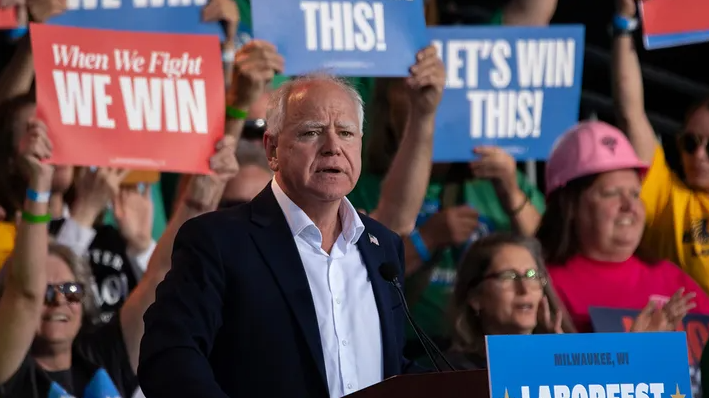Minnesota Governor Tim Walz has returned to the political stage in his home state armed with a hefty $1 million in campaign funds, a sign that his political ambitions may extend beyond the state’s borders. Following his unsuccessful bid as the Democratic vice-presidential nominee in the recent presidential election, Walz now faces a divided state legislature, a fractured public opinion, and the challenge of reshaping his political future.
Back in Minnesota, But Eyes on the Nation
Although Walz has resumed his role as governor, many speculate that he still has national aspirations. His substantial campaign war chest indicates that he could be preparing for a future run for higher office or looking to maintain influence on the national stage through key Democratic networks. His tenure as vice-presidential nominee raised his profile, but with that visibility comes increased scrutiny from political opponents at home.
“Walz isn’t coming back to Minnesota just to govern,” said a senior political strategist. “He’s looking ahead, whether it’s to the Senate or another national role.”
Challenges at Home: A Divided Legislature
Walz returns to a state deeply divided, with Republicans holding firm against much of his progressive agenda. The state legislature has been at odds with Walz over several major issues, including taxes, education reform, and public safety measures. Republican lawmakers have already signaled that they plan to challenge him on issues they see as critical to middle-class Minnesotans, particularly on crime and spending.
State Senator Mark Johnson (R-MN) didn’t hold back his criticism, stating, “Minnesota needs a leader who prioritizes its people, not someone looking for national headlines. Walz’s policies have hurt families, and it would be good for Minnesota to see him gone.”
Public Sentiment: Mixed Reactions to His Return
Public opinion on Walz remains divided. Some voters view him as a competent leader who navigated crises like the COVID-19 pandemic and promoted progressive initiatives. However, many Minnesotans blame his leadership for rising crime rates, high taxes, and poor handling of law enforcement issues, particularly following the unrest that gripped the state in the aftermath of the George Floyd riots.
“Walz left us with skyrocketing crime and cities in disarray,” said Jacob Reynolds, a Minneapolis resident and small business owner. “He’s been absent when we needed him most, and now he’s back after failing to win on the national stage.”
Polling data suggests that Walz’s approval ratings have fluctuated, with significant dissatisfaction among rural and suburban voters who have criticized his support for higher taxes and lenient crime policies. His allies, however, argue that his return will allow him to reset his image and push forward policies that benefit Minnesotans.
A Potential National Comeback?
While Walz focuses on navigating Minnesota’s challenges, many political analysts believe he is laying the groundwork for another national bid. His $1 million campaign fund could easily be deployed in a Senate race or as a foundation for a future presidential run. His connections within the Democratic Party remain strong, and some insiders speculate that he could become a key figure in party leadership discussions moving forward.
“Tim Walz may have lost the vice-presidential bid, but he’s still a name Democrats are keeping on the radar,” said political analyst Aaron Mitchell. “He’s got the experience, and depending on how the next few years go, he could re-emerge stronger.”
Key Policy Battles Ahead
To position himself for future success, Walz will need to navigate several key battles with the state legislature:
- Public Safety and Crime: Walz faces pressure to address rising crime in Minneapolis and other major cities. His previous reluctance to support tougher law enforcement policies has drawn significant criticism, and Republicans are expected to push for stricter measures.
- Tax Reform: With Minnesota residents complaining of a high tax burden, Republicans have vowed to block any attempts by Walz to raise taxes further. The state’s businesses, particularly in rural areas, have voiced concerns that current tax policies stifle growth.
- Education Funding: Walz has championed increased funding for public schools, but Republicans argue that without accountability and reform, additional funding will not address the state’s educational shortcomings.
Conclusion: Can Walz Rebuild His Political Capital?
Walz’s return to Minnesota is more than just a resumption of gubernatorial duties—it’s a test of whether he can overcome challenges at home while keeping his national prospects alive. With a divided state government and mounting opposition from conservative leaders, he will need to demonstrate that he can deliver tangible results for Minnesotans if he hopes to maintain relevance on the national stage.
As Republican lawmakers prepare to block much of his progressive agenda, and public sentiment remains divided, Walz’s ability to balance state governance with broader ambitions will be critical. Whether he succeeds or finds himself further sidelined will shape not only his political future but also the trajectory of Minnesota’s policies in the coming years. For now, all eyes are on whether Walz can navigate the storm or whether his time in the spotlight is coming to an end.


